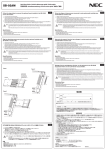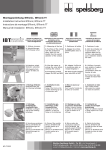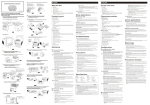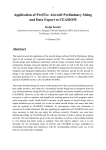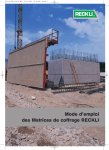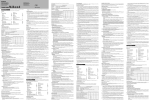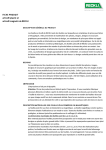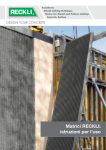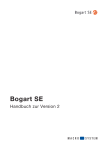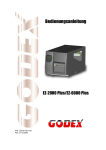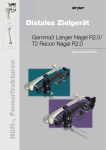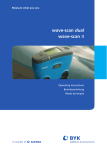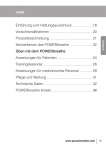Download RECKLI®- 1x-Schalungen RECKLI® One- Timer
Transcript
1107_D_GB_F.qxd:1107_D_GB_F.qxd 25.02.2008 17:37 Uhr Seite 1 RECKLI®1x-Schalungen RECKLI® OneTimer Formliners Matrices RECKLI® 1 emploi 1107_D_GB_F.qxd:1107_D_GB_F.qxd 25.02.2008 17:37 Uhr Seite 2 Programmübersicht · Summary · Sommaire Strukturart Kind of patterns Description de structure Name Name Nom Gewicht pro Stück Weight per piece Poids per pièce Stück/Box max. Pieces per box max. Quantité max. par caisse Holz-Strukturen Wood patterns Structures-bois 3/11 Paola 3/12 Christina 3/06 Lisa 20 kg 24 kg 14 kg 30 20 30 Putz-Strukturen Rough cast and Texture patterns Structures bouchardées 3/03 Regina 3/13 Nicola 18 kg 16 kg 30 30 Rippen-Strukturen Rib patterns Structures cannelées 3/07 Sonja 3/15 Caterina 3/16 Tanja 24 kg 30 kg 30 kg 20 20 20 Rippenbruch-Struktuen Broken rib patterns Cannelures éclatées 3/01 Patricia 3/14 Constanza 3/21 Julia 20 kg 15 kg 25 kg 30 30 20 Mauerwerk-Strukturen Brick and Masonry patterns Structures appareillées 3/70 Annalena 3/05 Ramona 22 kg 28 kg 20 20 Fantasie-Strukturen Abstract patterns Structures architectoniques 3/02 Anita 3/04 Larissa 21 kg 14 kg 20 30 Dimensions Abmessungen Dimensions 3,00 m x 0,75 m = 2,25 m /Stück 3.00 m x 0.75 m = 2.25 m /piece 3,00 m x 0,75 m = 2,25 m2/pièce Lieferpartie Unit of delivery Livraison unitaire 2 2 stückweise zu je 2,25 m min. 1 piece = 2.25 m par matrice de 2,25 m2 Verpackung Packing Emballage Einwegboxen One-way boxes caisses-palettes Verpackungseinheit Packing units Unité d’emballage max. 20-30 Stück/Box, max. 20-30 pieces/box max. 20-30 pièces par caisse abhängig von der Struktur depending on the kind of pattern selon le relief 2 2 2 1107_D_GB_F.qxd:1107_D_GB_F.qxd 25.02.2008 17:37 Uhr Seite 3 RECKLI-1x-Schalungen Beschreibung und Anwendung Material RECKLI®-1x-Schalungen bestehen aus einem Hartfaserrücken und einer hochelastischen Frontschicht aus Polyurethanschaum als Strukturgeber. Die hohe Elastizität dieser Kombination gewährleistet ein leichtes und beschädigungsloses Entschalen der Betonsichtflächen. Gleichzeitig ermöglicht diese Materialkombination bis zu einem gewissen Grad auch die Anwendung in gebogenen Bauteilen. Stöße Die Größe der 1x-Schalung ist auf ein Fixmaß von 3,00 m x 0,75 m begrenzt. Will man größere Deckflächen erreichen, so sind die Schalungen dicht aneinander zu stoßen. Die Produktionsränder bestehen ebenfalls aus elastischem Schaum, so dass sich die Schalungen leicht press aneinander setzen lassen, wodurch ein Auslaufen des Zementleimes (Ausbluten) an den Stößen vermieden wird. Bei Stößen quer zur Stuktur oder bei Strukturen ohne fortlaufendes Raster bietet es sich an, mit glatten Scheinfugen zu arbeiten, die den Strukturcharakter betonen und die Sichtfläche gliedern. Zuschnitt Mit Kreis- oder Handsägen lassen sich die Schalungen mühelos passgenau zuschneiden. Befestigung RECKLI®-1x-Schalungen werden auf die Trägerschalung mit gestauchten Nägeln aufgenagelt. Dabei sollte die Schalung vorzugsweise waagerecht liegen. Die Befestigung kann aber auch im Senkrechten erfolgen. Der Abstand der Nägel beträgt 20-25 cm. Der Nagelabstand vom Rand sollte ca. 3 cm nicht überschreiten. Verzinkte Nägel sind vorteilhaft, weil sie bei längerer Wartezeit bis zum Betonieren keine Rostflecken bilden. Abhängig von der Struktur sollte immer in die Strukturhochpunkte genagelt werden, da dann eventuelle Nagellöcher unauffällig im Beton tief liegen. Regelmäßig werden die gestauchten Köpfe aber in den elastischen Schaum dringen und das Nagelloch vom Schaum selbsttätig wieder verschlossen. Nägel mit Flachköpfen sind deshalb weniger geeignet. Konen/Distanzhülsen Abhängig von der Art der Struktur kann es Probleme bereiten, den Bereich der Konen für die Spreizen so abzudichten, dass es nicht zum Auslaufen von Zementleim (Ausblutungen) kommt. Um dies zu vermeiden, kann die 1x-Schalung mit einem Locheisen passgenau ausgestanzt und in dieses Stanzloch ein Elastomerring ohne Struktur mit entsprechendem Durchmesser eingesetzt werden, der eine ebene Auflage für den Konus der Spreize und somit eine hohe Dichtigkeit bietet. Trennmittel Als Betonentschalungsmittel ist das lösungsmittelhaltige RECKLI®-Trennwachs TL-SO oder das wässerige RECKLI®-Trennwachs TL-W zu verwenden. Es ist darauf zu achten, dass alle Strukturflanken ausreichend mit dem Trennmittel versehen werden. Zweimaliges Aufsprühen ist deshalb unerlässlich, wobei der erste Auftrag vollständig aufgetrocknet sein muss, bevor der zweite erfolgt. Die Trockenzeit ist stark abhängig von der Temperatur und der Luftzirkulation. Der Verbrauch beträgt je nach Struktur ca. 100150 g/qm je Auftrag. Der Trennmittelfilm muss vor Abregnen oder Abwittern geschützt werden. Betonieren Es kann wie üblich betoniert werden. Die Betonrezeptur sollte normgerecht sein. Die 1x-Schalungen sind bis ca. +60 °C wärmebeständig. Sollte aufgrund der Betonmassen, der Zementart, -güte und des -gehaltes, der Umgebungstemperatur oder sonstiger örtlicher Bedingungen zu erwarten sein, dass die Betontemperatur an der Kontaktfläche zu den 1x-Schalungen +60 °C überschreitet, so sind Maßnahmen zur Temperaturreduzierung zu treffen. Lagerung Um ein Anquellen des Hartfaserrückens durch Wassereinwirkung zu vermeiden, ist eine trockene Lagerung unumgänglich. Generell müssen die Schalungen vor Witterungseinflüssen z.B. durch Abdecken mit dunklen Folien geschützt werden. Maße / Toleranzen RECKLI®-1x-Schalungen werden in einem Fixformat von ca. 3,00 m x 0,75 m = 2,25 m2 geliefert. Struktur-, material- und fertigungsbedingt, lassen sich Maßunterschiede von ± 5mm in der Länge und Breite nicht vermeiden. In der Dicke sind ± 2 mm möglich. Diese Dickentoleranz kann sich insbesondere dann zeigen, wenn die Schalungen zersägt werden. Deshalb sollten möglichst immer Produktionsränder aneinander gestoßen werden, da in diesem Bereich die Toleranzen am geringsten sind. Die Maße in den Schnittzeichnungen der Strukturen sind nicht maßstabsgerechte Mittelwerte oder Nennmaße, die mit entsprechenden Toleranzen behaftet sind. Bei der Addition dieser Maße, zum Beispiel zur Ermittlung eines Rasters, kann nicht davon ausgegangen werden, dass sich das Rastermaß gleichmäßig wiederholt. Dies gilt sowohl beim Aneinanderstoßen von Matrizenabschnitten als auch ganzer Matrizen. Lieferung / Verpackung RECKLI®-1x-Schalungen werden ausschließlich im Fixformat von ca. 3,00 m x 0,75 m in stabilen Einweg-Paletten-Kisten geliefert. Die maximale Stückzahl pro Kiste ist abhängig von der Strukturart. Die Paletten-Kisten werden separat berechnet. Entschalen Wir empfehlen, das Entschalen so früh wie möglich vorzunehmen. Im Regelfall löst sich die Vorsatzschalung zusammen mit der Trägerschalung vom Beton. Es kann aber auch sein, dass sich die Nägel durch die Hartfaserplatte hindurch ziehen und die Vorsatzschalungen auf dem Beton verbleiben. Sie sind dann einzeln vom Betonteil zu entfernen. Die Trägerschalung muss danach entnagelt werden. 3 1107_D_GB_F.qxd:1107_D_GB_F.qxd 25.02.2008 17:37 Uhr Seite 4 RECKLI One-Timer Formliners Specification and Application Material RECKLI® One-Timer Formliners are designed with an elastic front wearing part that has the pattern/texture which is bonded to a hardboard as the backing. The high elasticity of this material combination guarantees an easy release of the formliners from the concrete ensuring a blemish and snag free finish. The formliner has a degree of flexibility, which will allow the contractor to use it on cambered, and radius work. Joints The sizes of the RECKLI® One-Timer Formliners have a fixed measurement of 3.00 m x 0.75 m For making larger size shutters and moulds, the formliners are butted together. The edges of the formliners being made from the flexible foam part can be pressed together tightly which will stop any ‘bleeding’ between the formliners. When it is necessary to increase the height to more than the 3 m it will be visually more acceptable to introduce ‘dummy’ joints either in the positive or the negative. This method is also valid for when the pattern can not be extended or matched. Cutting The formliner can be cut to size with hand or circular saws. Fixing RECKLI® One-Timer Formliners are to be nailed to the shutter/formwork with ‘lost heads’ or oval nails. The formliners can be fixed to the shutter either in the horizontal or vertical. Fixing centres should be 20 – 25 cms. Allow 2-3 cms, max. 3 cms from the edges of the formliners before fixing. If there is a delay in erecting the shutter on which the formliners are fixed consider using galvanised nails to resist any potential rust stains to the concrete especially in ‘insitu’ work. Depending on the pattern being used fixing should be in the highest part of the pattern and will therefore be in the deepest part of the concrete. It will be found that if the nails are punched home the foam will close over the nail hole. 4 Cones/Spacers Depending on the type of pattern being used there can be a potential problem of ensuring a tight fit round the ‘through tie’ cones and tube which would allow ‘bleeding’ in this area. This can be avoided when you make the holes for the ‘through ties’ by using the appropriate size punch tool. You can then place an elastic seal ring supplied by RECKLI with the same diameter on which you now press the cone. This method offers an efficient sealing for the ‘through ties’. Release Agent The release agent to be used with the RECKLI® One-Timer Formliners is our Stripping Wax TL-SO or Stripping Wax TL-W. Please take care that all sections, angles of the pattern are covered with the release agent. The formliners should have 2 applications of the wax. The first coat of wax should be dry before applying the second coat. Drying time for the release agents depends on ambient temperatures and air movement. Consumption is approx. 100 – 150 g/m2 depending on the type of pattern. The applied wax film must be protected against rain and other damaging weather conditions by covering with polyethylene sheets. Pouring & Casting For use with general B.S.concretes. The heat resistance of the One-Timer Formliner is approx. +60 ºC. If you expect concrete temperatures to exceed +60 ºC at the formliner face for whatever reason it will be necessary to reduce the temperature by suitable methods. Striking / Stripping Formwork / Moulds We recommend that this takes place as soon as possible. Usually One-Timer Formliners will release from concrete still fixed to the plywood shutter, but there could be instances where the shutter will come away by pulling the nails through the One-Timer leaving it on the concrete surface. Release the One-Timer from the concrete and pull nails from plywood shutter to reuse shutter. Storage Formliners must be stored in the dry. If building storage is not available make sure they are raised from the ground and covered securely with black polythene or other non-transparent covers. The hardboard backing must be protected from rain and damp. Size / Tolerances RECKLI® One-Timer Formliners are delivered in fixed sizes of 3.00 m x 0.75 m = 2.25 m2. Production methods dictate that tolerances will be ± 5 mm in length and width. Thickness tolerance is ± 2 mm. When cutting the liners to sizes the difference in thickness will be more apparent. Therefore we recommend when butting the formliners side by side to increase the width always use the formliners manufactured edge as the tolerances are at the lowest value at this point. The measurements shown in the sectional drawing under the pattern photos in this book are not to scale, average values and only nominal dimensions which have tolerances. In using these sizes for the calculation of your requirements you should not expect that there is an equal repetition of measurements within the same formliner. The same criteria will apply whether you place two full sizes sheet formliners together or two or more ‘made to measure’ (smaller) formliners. Delivery & Packing RECKLI® One-Timer Formliners are delivered only in a fixed format size of 3.00 m x 0.75 m and are packed in wooden pallet boxes. The maximum number of pieces of each pallet depends on the kind of pattern. The pallet boxes will be charged separately as packing. 1107_D_GB_F.qxd:1107_D_GB_F.qxd 25.02.2008 17:37 Uhr Seite 5 Matrices RECKLI 1 emploi Description et mode d’emploi Matériau Les matrices RECKLI® 1 emploi sont constituées d'un dos en fibres et d'une face coffrante structurée en mousse de polyuréthanne. L'élasticité élevée de cette combinaison autorise un démoulage sans problème des parements béton. Le système est également applicable, dans une certaine mesure à la production d'éléments courbes. Assemblage La dimension fixe des matrices est de 3,00 m x 0,75 m. Pour atteindre des dimensions supérieures, les éléments doivent être assemblés entre eux. Les chants sont en mousse souple, ce qui permet de comprimer légèrement les panneaux de matrices entre eux afin d'éviter toute fuite de laitance. Lorsque le motif n'est pas continu, nous conseillons de marquer un joint lisse entre deux panneaux au lieu de les comprimer. Découpes Procéder à l'aide d'une scie circulaire ou d'une scie égoïne. Fixation Les matrices RECKLI® 1 emploi seront fixées sur le coffrage support avec des clous tête homme zingués. Les coffrages devront être disposés de préférence à l'horizontale, mais il est toutefois possible d'opérer verticalement. L'espacement des clous sera d'environ 2025 cm et seront disposés en retrait du bord d'au moins 3 cm. Les clous zingués ont l'avantage de ne pas s'oxyder en laissant des traces de rouille sur le béton. Selon le type de structure, on devra pointer aux points les plus épais du relief de façon à ce qu'un trou éventuel reste caché dans les creux du béton. En règle générale, la mousse se referme sur les trous provoqués par les clous tête homme. C'est pourquoi les clous à tête plate sont déconseillés. Cônes, distanceurs Selon le type de structure, les cônes peuvent causer un problème en provoquant des fuites de laitance s'ils ne reposent pas sur toute leur surface sur le relief. Pour éviter cela, on peut pratiquer une ouverture dans la matrice 1 emploi avec un emporte pièce de section légèrement supérieure au cône que l'on reposera ainsi à plat sur un anneau lisse en élastomère disposé dans le trou pratiqué. Stockage Afin d'éviter un gonflement de la face fibreuse par absorption d'humidité, le stockage devra se faire au sec. En règle générale, il conviendra de protéger les coffrages contre les intempéries avec une feuille plastique opaque. Décoffrant Pour le traitement de la matrice, on utilisera soit la cire de démoulage TL-W en solution aqueuse, soit la cire de démoulage TL-SO à base de solvants. Il faut veiller à ce que toutes les faces des reliefs soient traitées. A cette fin, il est indispensable de passer deux couches de décoffrant en laissant sécher la première avant de passer la suivante. Le temps de séchage dépend fortement de la température et de la ventilation. La consommation se situe entre 100 et 150 g/m2 à chaque couche. Le film de cire doit être ensuite protégé des intempéries. La structure, le matériau et le procédé de fabrication font qu'on ne peut éviter des écarts de ± 5 mm en longueur et largeur. En épaisseur, une variation de ± 2 mm est possible. Des différences d'épaisseur peuvent apparaître principalement lorsque l'on découpe une matrice. Ces tolérances sont très réduites sur les bords lorsque l'on comprime deux matrices complètes. Bétonnage Le bétonnage s'effectue de la façon habituelle. Le béton devra, bien entendu, correspondre aux normes en vigueur. Les matrices RECKLI® 1 emploi résistent jusqu'à +60 °C. On devra donc veiller, en fonction de type de ciment, de son dosage, de la température ambiante et de toute autre condition particulière, à ce que la température à la surface de contact ne dépasse pas +60 °C. Dans le cas contraire, il conviendra de prendre toutes les mesures de modération thermique. Tolérances sur les dimensions Les matrices RECKLI® 1 emploi existent en format fixe de 3,00 m x 0,75 m = 2,25 m2. Les cotes figurant sur les dessins en coupe ne sont pas à l’échelle et sont des cotes moyennes qui présentent des tolérances. Lors de la juxtaposition de matrices, on ne peut pas considérer que les modules sont parfaitement égaux et une simple addition des mesures peut ne pas correspndre à la réalité. Livraison, emballage Les matrices RECKLI® 1 emploi sont livrables en format fixe de 3,00 m x 0,75 m et sont emballées sur des caisses-palettes en bois. Le nombre maximal de matrices par palette varie selon le genre de structure. Les caissepalettes seront facturées séparément. Décoffrage Nous conseillons de décoffrer aussi tôt que possible. Il peut toutefois arriver que les clous traversent la mousse et la fibre. Le support vient seul et il est alors aisé de séparer la matrice du béton sur lequel elle est restée. Il ne restera plus qu'à débarrasser le coffrage support des clous qu'il a entraînés. 5 1107_D_GB_F.qxd:1107_D_GB_F.qxd 6 25.02.2008 17:37 Uhr Seite 6 1107_D_GB_F.qxd:1107_D_GB_F.qxd 25.02.2008 17:37 Uhr Seite 7 3000 3/11 Paola 750 3 [mm] 93,7 93,7 8 93,7 7 1107_D_GB_F.qxd:1107_D_GB_F.qxd 8 25.02.2008 17:37 Uhr Seite 8 1107_D_GB_F.qxd:1107_D_GB_F.qxd 25.02.2008 17:37 Uhr Seite 9 3000 3/12 Christina 750 [mm] N 65 / 80 / 105 13 N 3 65 / 80 / 105 N N = Niveau 0 / 3 / 6 mm 9 1107_D_GB_F.qxd:1107_D_GB_F.qxd 10 25.02.2008 17:37 Uhr Seite 10 1107_D_GB_F.qxd:1107_D_GB_F.qxd 25.02.2008 17:37 Uhr Seite 11 3000 3/06 Lisa 83,3 8 83,3 3 750 [mm] 11 1107_D_GB_F.qxd:1107_D_GB_F.qxd 12 25.02.2008 17:37 Uhr Seite 12 1107_D_GB_F.qxd:1107_D_GB_F.qxd 25.02.2008 17:37 Uhr Seite 13 3000 3/03 Regina 750 17 3 [mm] 13 1107_D_GB_F.qxd:1107_D_GB_F.qxd 14 25.02.2008 17:37 Uhr Seite 14 1107_D_GB_F.qxd:1107_D_GB_F.qxd 25.02.2008 17:37 Uhr Seite 15 3000 3/13 Nicola 10 750 3 [mm] 15 1107_D_GB_F.qxd:1107_D_GB_F.qxd 16 25.02.2008 17:37 Uhr Seite 16 1107_D_GB_F.qxd:1107_D_GB_F.qxd 25.02.2008 17:37 Uhr Seite 17 3000 3/07 Sonja 10 10 115 23 115 3 8 750 [mm] 17 1107_D_GB_F.qxd:1107_D_GB_F.qxd 18 25.02.2008 17:37 Uhr Seite 18 1107_D_GB_F.qxd:1107_D_GB_F.qxd 25.02.2008 17:37 Uhr Seite 19 3/15 Caterina entspricht RIZ He-Gesi 01 Trapezprofile 3000 50 20 15 50 20 750 23 [mm] 3 20 19 1107_D_GB_F.qxd:1107_D_GB_F.qxd 20 25.02.2008 17:37 Uhr Seite 20 1107_D_GB_F.qxd:1107_D_GB_F.qxd 25.02.2008 17:37 Uhr Seite 21 3/16 Tanja entspricht RIZ He-Gesi 01 Segmentstäbe 3000 120 63 57 R30 20 750 23 [mm] 3 20 21 1107_D_GB_F.qxd:1107_D_GB_F.qxd 22 25.02.2008 17:37 Uhr Seite 22 1107_D_GB_F.qxd:1107_D_GB_F.qxd 25.02.2008 17:37 Uhr Seite 23 3000 3/01 Patricia 750 [mm] 3 11 18 34,1 23 1107_D_GB_F.qxd:1107_D_GB_F.qxd 24 25.02.2008 17:37 Uhr Seite 24 1107_D_GB_F.qxd:1107_D_GB_F.qxd 25.02.2008 17:37 Uhr Seite 25 3000 3/14 Constanza 15 13 10 3 750 [mm] 25 1107_D_GB_F.qxd:1107_D_GB_F.qxd 26 25.02.2008 17:37 Uhr Seite 26 1107_D_GB_F.qxd:1107_D_GB_F.qxd 25.02.2008 17:37 Uhr Seite 27 3000 3/21 Julia 750 [mm] 20 25 30 20 10 3 30 27 1107_D_GB_F.qxd:1107_D_GB_F.qxd 28 25.02.2008 17:37 Uhr Seite 28 1107_D_GB_F.qxd:1107_D_GB_F.qxd 25.02.2008 17:37 Uhr Seite 29 17,5 750 170 17,5 170 Stofl / joint / raccord 3/70 Annalena 3000 15 20 25 360 3 [mm] 29 1107_D_GB_F.qxd:1107_D_GB_F.qxd 30 25.02.2008 17:37 Uhr Seite 30 1107_D_GB_F.qxd:1107_D_GB_F.qxd 25.02.2008 17:37 Uhr Seite 31 750 100 - 150 25 - 70 Stofl . joint . raccord 3/05 Ramona 3000 30 15 - 50 3 130 - 435 13 [mm] 31 1107_D_GB_F.qxd:1107_D_GB_F.qxd 32 25.02.2008 17:37 Uhr Seite 32 1107_D_GB_F.qxd:1107_D_GB_F.qxd 25.02.2008 17:37 Uhr Seite 33 3000 3/02 Anita 750 [mm] 55 - 180 22 - 42 3 18 - 42 18 8 33 1107_D_GB_F.qxd:1107_D_GB_F.qxd 34 25.02.2008 17:37 Uhr Seite 34 1107_D_GB_F.qxd:1107_D_GB_F.qxd 25.02.2008 17:37 Uhr Seite 35 3000 3/04 Larissa 750 8 3 [mm] 35 1107_D_GB_F.qxd:1107_D_GB_F.qxd 25.02.2008 17:37 Uhr Seite 36 RECKLI®1x-Schalungen RECKLI® Matrices One-Timer Formliners RECKLI® 1 emploi die Strukturvorsatzschalung für den einmaligen Einsatz The flexible Single Use Formliner Le procédé de structuration à emploi unique • flexibel • flexible • flexible • biegsam • pliable • élastique • handlich • easy to handle • pratique • geringes Gewicht • low weight • léger • schnell zugeschnitten • simple to cut and shape • simple á couper • einfach aufnageln • fixed with nails • facile à clouer • leicht zu entschalen • easy to strip • décoffrage aisé • Fixformate 3,00 m x 0,75 m • fixed format sizes 3.00 m x 0.75 m • format fixe 3,00 m x 0,75 m Die ideale Ergänzung zu den RECKLI®-Strukturmatrizen mit zig-facher Wiederverwendung. The perfect partner to RECKLI®’s multi-reusable formliners. Le complément idéal au programme des matrices structurées RECKLI®. Ihr Ansprechpartner / Your agency / Votre agence RECKLI-Chemiewerkstoff GmbH Adresse/Address: Eschstraße 30 44629 Herne Germany Tel. ++49 / (0) 23 23 /1706-0 [email protected] Postadresse/Mailing Address: Postfach 1013 29 44603 Herne Germany Fax ++49 / (0) 23 23 /1706-50 http://www.reckli.de 1107 / 03/08 / MW Strukturmatrizen Abformtechnik Formen- und Modellbauharze




































